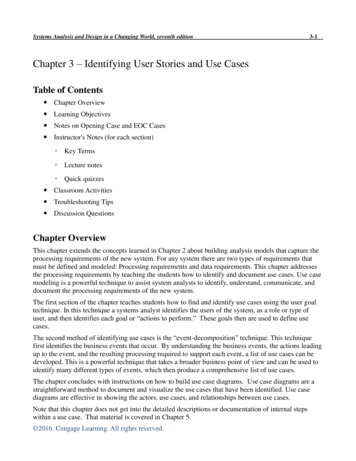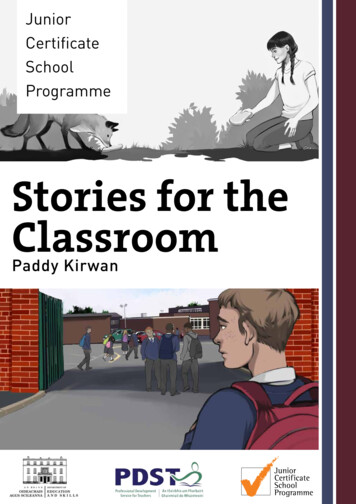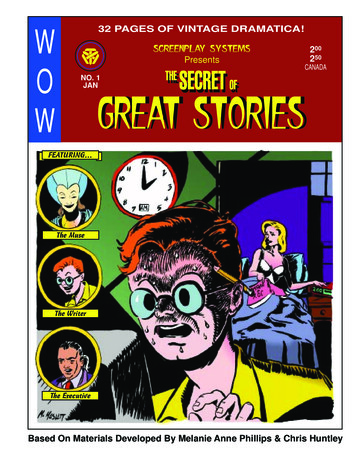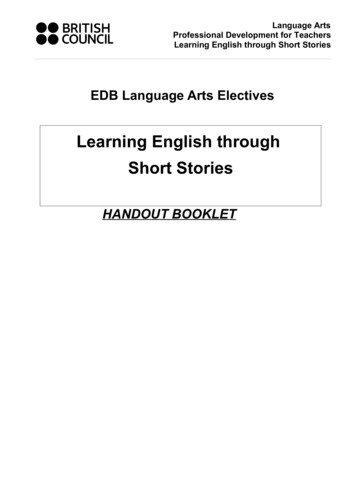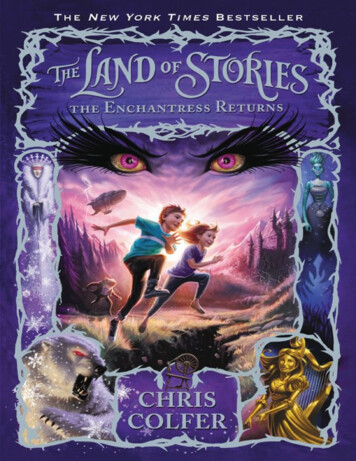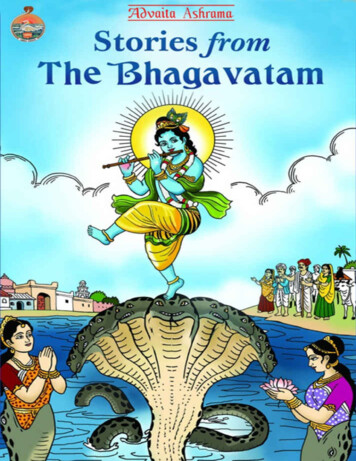
Transcription
Stories fromThe BhagavatamSwami Bodhasarananda
( PUBLICATION DEPARTMENT )5 DEHI ENTALLY ROAD KOLKATA 700 014
ContentsPublisher’s NoteIntroductionBOOK ONEA Minstrel Shares the BhagavataThe Incarnation StoryKing ParikshitBOOK TWOShukadeva’s AdviceThe Story of KhatvangaBOOK THREEVidura Meets Uddhava and MaitreyaJaya and Vijaya
Kapila MuniBOOK FOURDaksha’s Sacrifice and the Death of SatiThe Story of DhruvaThe Story of PuranjanaBOOK FIVEJada BharataBOOK SIXAjamilaDadhichi’s gift, and the killing of VritrasuraBOOK SEVENPrahladaBOOK EIGHT
The Liberation of the Elephant KingThe Churning of the OceanBali and VamanaIncarnation as a FishBOOK NINEAmbarisha and DurvasaSagara and the Descent of the GangaThe Incarnation of RamaThe Story of ParashuramaYayati and DevayaniDushyanta and ShakuntalaRantidevaBOOK TENThe Birth of Sri KrishnaThe Salvation of PutanaShakatasura and Trinavarta
Yashoda sees the Universe in KrishnaSri Krishna is BoundNalakubara and Manigriva are LiberatedBrahma’s Doubts are RemovedThe Serpent Kaliya is TamedBalarama Kills the Demon PralambhaKrishna Steals the Gopis’ ClothesKrishna Blesses the Pious Brahmin WomenLifting Mount GovardhanaRasa LilaSudarshana, Shankhachuda, and ArishtasuraAkrura Comes for Krishna and BalaramaThe Killing of KamsaUgrasena is EnthronedGuru-dakshina of Krishna and BalaramaUddhava and the Gopis’ ComplaintNews from Hastinapura
Fight with JarasandhaKalayavana and MuchukundaRukmini Marries KrishnaPradyumnaThe Syamantaka Jewel: Jambavati and SatyabhamaA Conversation with Kunti in IndraprasthaUsha and AniruddhaNarada’s Visit to DwarakaThe Killing of JarasandhaThe Rajasuya Yajna and the Killing of ShishupalaDestruction of Shalva and DantavaktraThe Story of SridamaVrikasura Attacks MahadevaBhrigu’s footprintDwaraka and the Yadu DynastyBOOK ELEVENThe Curse of the Sages
The Nava-yogisSri Krishna and UddhavaUddhava GitaThe Twenty-Four Gurus of the AvadhutaBondage and FreedomThe Glory of GodQuestions and AnswersThe last Advice of Sri Krishna to UddhavaKrishna Returns to His Heavenly RealmBOOK TWELVEYuga Dharma and the last advice of ShukadevaParikshit’s IlluminationThe Snake Yajna of JanamejayaThe Story of MarkandeyaThe Essence of the Bhagavatam in four Shlokas
Publisher’s NoteThe Bhagavata Purana has for centuries been one of the favouritereligious texts of India, and this is mostly because of its charming andattractive stories. For those people whose busy schedule does not allowthem time to go through the complete Purana, we have brought outthis collection of stories from the Bhagavatam.Here readers will find all their favourite stories—the story ofPrahlada, of Dhruva, of King Bharata, and many more. There arestories of rishis, kings, heroes, avataras, and of devas and asuras. Butalong with the stories, the Bhagavatam also presents relevantteachings.What the Bhagavatam is most known for, however, are the storiesof Krishna’s life, from his birth in a dungeon in Mathura to his passingaway at Prabhas. Almost all his stories are included in this volume—his childhood in Vrindavan, his youth in Mathura, and his later yearsin Dwaraka.In order to keep the volume to a reasonable length, we have hadto condense these accounts. However, the main points of the storiesare contained here. This volume is especially helpful for readers whodo not yet know the stories and would like to learn them. But it is alsohelpful for readers who know the stories already—or at least some ofthem—as this volume will refresh their memories and also help themlearn many new stories. And, above all, it is an invaluable reference forchildren.We are extremely grateful to Pravrajika Shuddhatmaprana formeticulously editing the original manuscript and also writing athoughtful introduction. Mahendra Zinzuvadiya has drawn thebeautiful sketches which adorn the book and Shubhabrata Chandrahas designed its cover.
May the ageless stories contained in this book fill the minds of itsreaders with devotion for the Supreme Being.PublisherNovember 2014
IntroductionFew scriptures have had such great influence on a religion and cultureas the Srimad Bhagavatam has. Along with the Bhagavad Gita and thevarious versions of the Ramayana, it has been the main text of most ofthe Vaishnava schools of India after Ramanuja. Probably composed inits final form around the tenth century, it was greatly influenced by theAdvaita school of Vedanta—though Visishtadvaita and Dvaita are alsogiven their due. But in spite of the Advaitic theology in it, theBhagavatam was also heavily influenced by the songs of ecstatic divinelove written by the Alvars, the Vaishnava saints of Tamil Nadu wholived between the sixth and ninth centuries.The Alvar songs set a new standard for devotional fervour andpoetry. Loving devotion became ecstatic devotion. Devotional poetrybecame sublime lyricism. This influence on the Bhagavatam canclearly be seen if we compare sections of the older Vishnu Purana withthose in the later Bhagavatam.Though most of the stories in the Bhagavata Purana are basicallythe same as those in the Vishnu Purana, the relationship between theLord and his devotees takes a new turn in the Bhagavatam, and thisalso brings about a change in the teachings and philosophy. Forinstance, in the stories of both Prahlada and the gopis in theBhagavatam, their minds become so absorbed in the thought of theLord that they feel they are the Lord, and they start imitating some ofhis actions.Why are these stories so important? Myths and religious storiesare actually pointers to another realm, a divine realm. They raise ourawareness away from this mundane physical plane and take us to ahigher plane of consciousness. Sometimes they do this throughobvious teachings, sometimes through allegories, but very often theydo it by working on a deeper level of our consciousness and we arehardly aware of the impact they make on us.
The story of the Avadhuta, given in the 11th skandha of theBhagavatam, would be an example of a story with obvious teachings.So also is the story of King Bharata, in the 5th skandha. There theteachings are spelled out. Regarding allegories, the Bhagavatam itselfunabashedly admits that the story of Puranjana in the 4th skandha isan allegory. Probably the story of Gajendra, in the 8th skandha, is alsoone.One of the most wonderful examples of the third kind of story, ormyth—that is, one that works on a deeper level of our consciousness—is the story of Markandeya, given in the 12th skandha. This is a type ofmyth that has no particular ‘meaning’ that we can attribute to it. Itspeaks of a mysterious spiritual experience, and works on the subtlelevel of our mind to awaken our spiritual consciousness.But then there are stories like that of Prahlada, which are possiblya combination of some or all of the above. They are partly teachings,partly allegorical, and partly pure myth. Readers should feel free tocheck out all the stories presented here and make their ownjudgements. But, as we said, readers should also remember, not allstories have ‘meanings’.The stories of Krishna, which comprise the largest section of theBhagavatam, most likely also have a combination of all these elements.Though there may be teachings, and there may even be allegories, yetthe general rasa (flavour) of each story is meant to be savoured within.The stories are meant to feed our inner soul. Otherwise, much of thebenefit is lost.We should also remember that there are many Puranas that givethese same stories. But just as there are many Ramayanas that telldifferent versions of the story of Rama and Sita, so also each Puranatells its own version of each story. In fact, the Bhagavatam itself has itsown version of the Ramayana—one with a surprising twist to it.Why don’t the Puranas all tell the same version of each story?What the Puranas are trying to say is that it doesn’t matter if there aredifferent versions of the same story. And, in fact, it doesn’t even matter
if these stories are historical or not. The point is not whether Krishnalived at a certain time and enacted a certain lila in a certain way, andat a certain place. For the devotees, the real point is that Krishna livesnow—here and now. For them, he still exists and he is still enacting hislilas. The same goes for Rama and other characters from these stories.The point the Puranas are making is that if we listen to these storieswith our minds as well as our ears—really listen to them—the divinedramas of Krishna (or Rama) will be awakened in our heart.These Puranas then—and particularly the Bhagavata Purana—aremanuals for spiritual life. The stories are there to inspire us to searchwithin. The more we get a taste for them, the more they will work onour minds. This is why the present volume focuses on the stories.However, we still must face critics who dismiss myths and storiesas being unhistorical and unscientific. Such critics cannot understandwhat relevance these stories can possibly have for people of our time.To answer this, Swami Vivekananda said to an audience in the USA, ‘Itis good for you to remember, in this country especially, that theworld’s great spiritual giants have all been produced only by thosereligious sects which have been in possession of very rich mythologyand ritual.’ (1)Bemoaning the lack of development of myth in Westerncivilizations, Carl Jung once wrote: ‘Our myth has become mute, andgives no answers. The fault lies not in it as it is set down in thescriptures, but solely in us, who have not developed it further, who,rather, have suppressed any such attempts. The original version of themyth offers ample points of departure and possibilities ofdevelopment.’ We are very fortunate that this is not the case in India.Perhaps no other country in the world has delighted so much in thedevelopment and redevelopment of its mythology as India. And this isone of the reasons why, when Westerners visit India, they oftenmention how they are inspired by the spiritual atmosphere there.Western countries need to take note of this. Is a totally ‘rational’or totally ‘scientific’ outlook enough to feed the spirit within? Besidesfeeding our religious instincts, mythology also feeds our poetry and all
the other arts. And what would life be like without them?[1] Complete Works of Swami Vivekananda, 2.392
BOOK ONEA Minstrel Shares the BhagavataLONG AGO IN THE NAIMISHA FOREST in India, Shaunaka, along with someother rishis, decided to hold a religious ceremony that would last formany years and which many other saints and holy men could take partin.In those days there were saintly minstrels who sang and recitedthe holy puranas, scriptures that give stories of the gods andgoddesses. These storytellers were called Sutas. The great SutaUgrashrava, son of Romaharshana, was one of them. When he arrivedto take part in the ceremony at Naimisharanya, all the other saints,sages, and holy people were pleased. With great respect, they askedhim to recite the stories of Lord Hari—especially of his divine play asKrishna.Suta Ugrashrava was delighted. He said: ‘When you ask about theBhagavatam, the story of the one called Krishna, or Vasudeva, you aretalking about the story of the Supreme Being. The Vedas find theirfulfilment in Vasudeva; the goal of all sacrifice is Vasudeva; the fruit ofall yoga is Vasudeva; the end of all actions is Vasudeva. Wisdom,austerities, and holy living are all contained in Vasudeva. Vasudevaalone is the goal of all.‘He who is Vasudeva, Sri Krishna, is the ever-playful Sri Hari. It isHe who incarnates himself as the avatara in different ages. Thesupremely wise Vyasa recounted the story of his life, activities, andteachings in the Bhagavata Purana, and he then taught it to his sonShukadeva. When, after the death of Sri Krishna, everything wasengulfed in darkness, this Bhagavata Purana was the sun, illuminatingthe world with spiritual truth. When King Parikshit heard theBhagavata Purana from Shukadeva, I too was there, listening with
great attention. Whatever I heard from him, I shall narrate to all ofyou now as best I can.’
The Incarnation StoryAt the beginning of creation, God assumed his Cosmic Form(Virat), which is the source of his many incarnations (avataras), andinto which they withdraw. From him also, all the gods, human beings,and sub-human creatures have been created.Ten avataras are usually spoken of, but the Bhagavatam speaks oftwenty-four and of even more than that. As countless streams flowfrom a single lake, so also countless incarnations spring from Sri Hari,the source of creation. Some are portions of him, some aretransformations of his qualities into human terms. But Sri Krishna isGod himself. He kindly incarnates himself in every age to save us fromsufferings produced by various causes.Shaunaka then asked Suta: Shukadeva is an ever-free soul and isthe greatest among the ascetics, and he is always absorbed in the blissof the Self. Why then did he take up the study of this scripture?Suta replied: Such are the blessed qualities of the Supreme LordHari that even those sages whose sole delight is in the Self and whosebonds of ignorance have been severed—even they have spontaneouslove for the Lord. Moreover, besides being drawn to the wonderfulqualities of the Lord, Shuka is also fond of the devotees, so he learnedthis text in order to relate it to the devotees.Suta continued: I shall now relate to all of you the story of KingParikshit’s life.
King ParikshitKing Parikshit was the son of the great hero Abhimanyu, who washimself the son of another great hero, Arjuna, one of the five Pandavabrothers. While still in his mother’s womb, Parikshit had been savedfrom the deadly brahmastra weapon by Sri Krishna. Later, before thePandavas left on their final earthly journey, King Yudhishthira gavehis kingdom to Parikshit, and installed him on the royal throne.Parikshit then ruled and protected the vast kingdom and its subjectswith great heroism and righteousness.One
31.12.2020 · Bhagavatam was also heavily influenced by the songs of ecstatic divine love written by the Alvars, the Vaishnava saints of Tamil Nadu who lived between the sixth and ninth centuries. The Alvar songs set a new standard for devotional fervour and poetry. Loving devotion became ecstatic devotion. Devotional poetry became sublime lyricism. This influence on the Bhagavatam can
